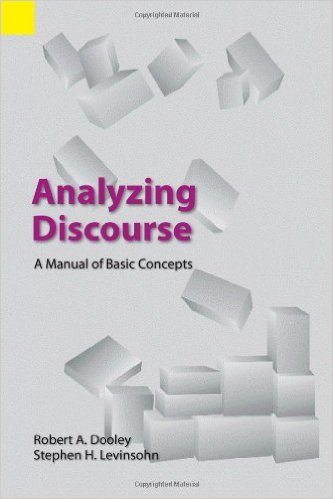 Dooley, Robert and Stephen H. Levinsohn. Analyzing Discourse: A Manual of Basic Concepts
Dooley, Robert and Stephen H. Levinsohn. Analyzing Discourse: A Manual of Basic Concepts. Dallas, TX: SIL International, 2001. 172 pp.
This work is brief and introductory, with most chapters spanning only 4-10 pages. It covers various concepts utilized in discourse analysis and uses language that is, for the most part, accessible for most readers. Chapters 1-4 cover respectively the four different dimensions of a text: (1) number of speakers (monologue or dialogue); (2) text genre; (3) style and register; (4) medium of production (oral versus written).
Chapters 5-15 cover common characteristic in discourses, such as coherence, cohesion, mental representations, activation status, discourse-pragmatics, foreground and background, logical proposition analysis, and analyzing conversations.
Chapter 7 offers the reader a method of “text charting,” although it is different from any conventional diagramming method (to this reader, at least) and, given only a 4.5 page explanation, the reader is left wondering how to execute this method on texts and what benefit it could reap.
Chapters 16-18 covers the linguistic phenomenon of reference in discourse, paying special attention to the amount of “coding” that is embedded in referring expressions and how such expressions are given pragmatic emphasis (or not). Chapter 17 discusses two types of references in discourse, sequential and VIP (very important participant) strategies, and chapter 18 provides a methodology for discovering reference strategies in a discourse.
Positively, this work introduces readers to possibly foreign concepts with decently lucid language and in an accessible form. The reader is introduced to common terminology within the field of discourse analysis. Negatively, this work could be improved by a greater amount of examples. When linguistic concepts are discussed, they are sometimes incomprehensible for those not familiar with the field and the typical examples of linguistic phenomena.
Perhaps the greatest downfall to this book, along with many others, is that no methodology is provided for the reader to perform discourse analysis. The reader is given a methodology for charting texts and discovering reference strategies, but nothing like a guide to a full-scale analysis of a discourse that utilizes the concepts discussed in the book, such as coherence and cohesion.
Find it here on Amazon.
